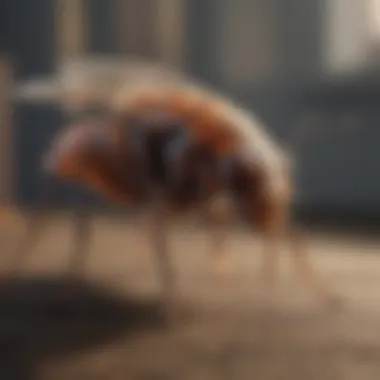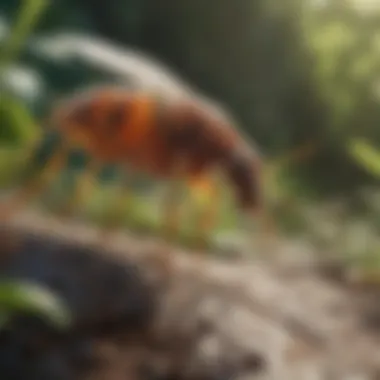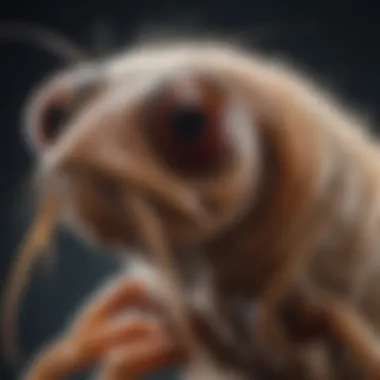Expert Strategies for Eliminating Fleas: A Comprehensive Guide for Success


Preventive Pest Control Strategies
When dealing with the persistent nuisance of flea infestations, a proactive approach is paramount in effectively eradicating these pests from your living spaces. Preventive pest control strategies serve as the first line of defense against these unwanted intruders. One of the fundamental aspects of pest control is safeguarding your house's exterior. This involves meticulously sealing cracks and crevices that might serve as entry points for fleas. Furthermore, clearing debris in and around your house can eliminate potential breeding grounds for pests. Preventing pests from entering your home requires a combination of vigilance and strategic planning.
Yard maintenance plays a crucial role in flea prevention. Implementing essential yard care routines such as regular mowing and trimming vegetation can significantly reduce flea populations. Additionally, employing methods like removing excess moisture and clutter from your yard can help in keeping the outdoor space pest-free. Indoors, cleanliness is key to creating a pest-resistant environment. Following expert cleaning tips and techniques can help in eradicating flea eggs and larvae, curbing infestations effectively. Maintaining a hygienic indoor space also involves proper waste disposal. Adopting efficient waste disposal methods and emphasizing the importance of disposing of garbage properly can deter fleas from thriving.
In addition to these conventional methods, there are innovative pest prevention strategies that can further assist in safeguarding your home against flea infestations.
Understanding Flea Infestation
Flea infestation is a common yet troublesome issue that many homeowners face. In this comprehensive guide, we delve deep into the intricacies of flea infestation and provide detailed insights on how to effectively rid your living spaces of these pesky creatures. Understanding the root causes of flea infestation is crucial in devising a targeted and successful eradication plan. By comprehending the behavior and characteristics of fleas, you can implement strategic measures to combat and prevent their presence in your home.
What Are Fleas?
Physical Characteristics of Fleas
Fleas are tiny, wingless insects known for their exceptional jumping abilities and flattened bodies, allowing them to move swiftly through fur or carpets. Their dark brown coloration aids in blending seamlessly with their environment, making them challenging to spot. Understanding these physical traits is imperative in identifying and targeting fleas effectively. While their size may be minuscule, their resilience and agility make them formidable opponents in the battle against infestation.
Behavioral Patterns of Fleas
The behavioral patterns of fleas revolve around their feeding habits and reproduction cycles. Fleas are hematophagous creatures, relying on blood for survival and reproduction. Their reproductive rate is astonishing, with females capable of laying hundreds of eggs within a short period. This rapid reproductive cycle contributes to the fast spread of infestation. By comprehending these behavioral tendencies, homeowners can implement strategies to disrupt and eradicate flea populations efficiently.
Common Causes of Flea Infestation
Pet Transmission
One of the primary causes of flea infestation is pet transmission. Fleas often hitch a ride on household pets, such as cats and dogs, easily entering the home environment. Once indoors, fleas establish themselves in carpets, upholstery, and bedding, making it crucial to address pet infestations promptly. Regular pet grooming and preventive measures are essential in curbing the spread of fleas through pet transmission.
Outdoor Exposure


Outdoor exposure to flea-infested environments, such as grassy areas and parks, can also lead to infestations inside the home. Fleas can latch onto clothing and shoes, gaining access to indoor spaces. Understanding the risks associated with outdoor exposure is vital in preemptively combating flea infestations. By adopting preventive measures before entering the home, homeowners can mitigate the risk of outdoor exposure leading to infestations.
Detecting Flea Infestation
Signs of Fleas on Pets
Detecting signs of fleas on pets is crucial in early identification and intervention. Common signs include excessive scratching, red and inflamed skin, and visible dark specks on fur, indicating flea dirt. By closely observing these symptoms, pet owners can promptly address infestations through appropriate treatments. Recognizing the signs of fleas on pets is key to preventing further spread to the home environment.
Identifying Fleas in the Environment
Identifying fleas in the environment entails thorough inspection of carpets, bedding, and furniture for signs of infestation. Flea eggs, larvae, and adult fleas may be present in these areas, requiring detailed scrutiny for detection. Understanding where fleas hide and thrive within the home is critical in implementing targeted eradication methods to eliminate infestations at their source.
Preventive Measures Against Fleas
In this extensive article dedicated to combating flea infestation, it is crucial to emphasize the significance of preventive measures in effectively addressing this issue. By implementing proactive strategies to keep fleas at bay, individuals can safeguard their living spaces and pets from infestations. Preventive measures not only serve as a protective barrier but also play a vital role in minimizing the risk of recurrent outbreaks. Understanding the importance of prevention is key to achieving long-term success in eradicating fleas.
Maintaining Hygiene
Regular Cleaning Practices
Regular Cleaning Practices are fundamental in mitigating the spread of fleas and their eggs within the home environment. The meticulous cleaning of floors, carpets, and upholstery helps eliminate flea eggs and larvae, disrupting their life cycle and reducing infestation risks. Vacuuming regularly, washing pet bedding frequently, and cleaning any areas where pets frequent are essential steps in preventing flea proliferation. The consistency of these practices is essential for breaking the breeding cycle of fleas and ensuring a pest-free environment.
Pet Grooming Tips
Pet Grooming Tips play a crucial role in preventing flea infestations by maintaining the cleanliness and health of pets. Regular grooming sessions not only help in detecting early signs of flea presence but also enable pet owners to monitor their pets' overall well-being. Bathing pets with vet-approved shampoos, using flea combs, and trimming long fur can aid in reducing the risk of flea infestations. Proper grooming not only enhances the pet's hygiene but also supports a holistic approach to flea prevention.
Environmental Modifications
Yard Maintenance
Yard Maintenance is instrumental in creating a deterrent for fleas in outdoor spaces, especially in areas frequented by pets. Regularly mowing the lawn, removing debris, and trimming vegetation helps eliminate breeding grounds for fleas. Creating a barrier of gravel or wood chips between the lawn and potential entry points for fleas can further deter infestations. By maintaining a well-groomed yard, individuals can minimize the risk of flea exposure to their pets and ultimately prevent infestations.


Indoor Pest Control
Indoor Pest Control involves adopting measures to limit the entry and proliferation of fleas within the household. Utilizing pet-safe indoor insecticides, sealing entry points, and maintaining a clutter-free environment are key aspects of indoor pest control. Removing potential hiding spots for fleas, such as piles of laundry or boxes, and addressing any structural issues that may facilitate flea entry are vital steps in mitigating infestation risks. Indoor pest control strategies complement other preventive measures, ensuring a comprehensive approach to flea management.
Utilizing Natural Repellents
Essential Oils
Essential Oils have gained popularity as natural flea repellents due to their aromatic and insect-repelling properties. Oils such as lavender, peppermint, and tea tree are known for their flea-repelling effects when used in diffusers or diluted sprays. Essential oils not only serve as safe alternatives to chemical insecticides but also provide a pleasant aroma to living spaces. While essential oils offer an eco-friendly approach to flea control, it is essential to use them cautiously around pets, considering their sensitivity to certain oils.
Herbal Remedies
Herbal Remedies present natural alternatives for repelling fleas and maintaining a pest-free environment. Botanical solutions like lemongrass, neem, and cedar chips are used for their flea-repellent properties in various forms, including sachets, sprays, and topical applications. Herbal remedies offer non-toxic options for flea control, promoting a safer living environment for both pets and humans. Integrating herbal remedies into preventive measures can enhance the overall efficacy of flea management strategies, aligning with a chemical-free approach to pest control.
Eradicating Fleas Effectively
Eradicating Fleas Effectively is a crucial aspect when dealing with a flea infestation. In this section, we will explore the various methods and strategies to effectively eliminate fleas from your living spaces. By focusing on eradicating fleas, you can ensure a clean and pest-free environment for your family and pets.
Home Treatments
Vacuuming Strategies
Vacuuming Strategies play a vital role in eradicating flea infestations. By regularly vacuuming your carpets, rugs, and furniture, you can effectively remove flea eggs, larvae, and adult fleas, breaking the flea life cycle. The key characteristic of Vacuuming Strategies lies in their ability to physically remove fleas from your home, reducing the infestation levels significantly. This method is a popular choice in combating fleas due to its non-toxic nature and effectiveness in reducing flea populations. However, one disadvantage of Vacuuming Strategies is that it may not completely eliminate all fleas, requiring additional treatment methods.
Flea Spray Application
Flea Spray Application is another essential component of eradicating fleas effectively. By using flea sprays specially formulated to target fleas, you can directly eliminate adult fleas on contact. The key characteristic of Flea Spray Application is its targeted approach, allowing you to treat specific areas where fleas are present. This method is beneficial as it provides quick results and can be used to treat both indoor and outdoor spaces. However, a potential disadvantage of Flea Spray Application is the presence of chemicals in some sprays, requiring caution when using around children and pets.
Professional Pest Control Services


When home treatments are not sufficient, turning to Professional Pest Control Services can offer a more comprehensive and effective solution. By hiring experts in flea control, you can benefit from their knowledge and experience in dealing with stubborn flea infestations. The key characteristic of Professional Pest Control Services is their expertise in identifying the severity of the infestation and tailoring a treatment plan accordingly. This option is popular for its convenience and long-term effectiveness in eradicating fleas from your home. However, one consideration is the cost associated with professional services, which may be higher than DIY methods.
Treatment Process Overview
Understanding the Treatment Process Overview is essential when opting for professional pest control services. This overview typically includes inspection, treatment application, and follow-up visits to monitor the progress. The key characteristic of the Treatment Process Overview is its systematic approach to targeting fleas at every stage of their life cycle. This process is beneficial as it ensures thorough treatment of your home, reducing the chances of reinfestation. However, a potential disadvantage is the need for repeated treatments in severe infestations, leading to additional costs and time investment.
Pet-Specific Solutions
Pets play a significant role in flea infestations, making Pet-Specific Solutions crucial in eradicating fleas effectively. Veterinary Recommendations offer tailored advice on flea treatments suitable for your pets, taking into account their health and specific needs. The key characteristic of Veterinary Recommendations is their expertise in recommending safe and effective flea control products for pets. This option is popular among pet owners for its focus on animal well-being while combating fleas. However, one consideration is the need for regular consultations with veterinarians for optimal flea prevention.
Topical Flea Treatments
Topical Flea Treatments provide a direct and targeted solution for treating fleas on pets. By applying topical treatments to your pets' skin, you can effectively kill adult fleas and prevent new infestations. The key characteristic of Topical Flea Treatments is their ease of application and long-lasting efficacy against fleas. This method is popular for its convenience and effectiveness in protecting pets from flea-related issues. However, a potential disadvantage of Topical Flea Treatments is the possibility of skin reactions in some pets, necessitating careful observation after application.
Sustaining Flea-Free Environments
Maintaining a flea-free environment is paramount to ensure the health and well-being of your household. In this section, we delto prevent infestations is by regularly inspecting your pets for any signs of fleas and ensuring they receive proper treatment. Routine checks of your home and outdoor areas are also crucial in detecting any flea presence early on. A proactive approach to attending to any potential infestations can save you time and money in the long run.
Regular Monitoring Practices
Observation Techniques
Observation techniques play a vital role in maintaining a flea-free environment. By carefully observing your surroundings, you can pinpoint potential areas of infestation and take prompt action to address them. This proactive approach allows you to nip flea problems in the bud before they escalate, contributing to a healthier living space for you and your pets. The key characteristic of observation techniques lies in their ability to detect early signs of flea activity, enabling you to implement necessary measures swiftly. While observation techniques require diligence and attention to detail, their effectiveness in preventing infestations makes them a popular choice for households seeking long-term flea control solutions.
Frequent Checks
Frequent checks are essential for effective flea control and prevention. By conducting regular inspections of your pets, living areas, and yard, you can stay ahead of potential infestations and address any issues promptly. The key characteristic of frequent checks is their proactive nature, allowing you to detect fleas early on and take immediate action. While frequent checks may require consistent effort, their benefits in maintaining a flea-free environment far outweigh the minor inconvenience. By incorporating frequent checks into your routine, you can significantly reduce the risk of flea infestations and enjoy a pest-free home.
Long-Term Prevention Strategies
Consistent Flea Control Measures
Consistent flea control measures are essential for long-term prevention of infestations. By implementing regular flea treatments for your pets and treating your home and yard with effective pest control products, you can create an inhospitable environment for fleas. The key characteristic of consistent flea control measures lies in their ongoing nature, providing continuous protection against flea infestations. While consistent flea control measures may require dedication and adherence to a routine, their effectiveness in preventing infestations makes them a popular choice for households seeking sustainable solutions.
Consulting Professionals Periodically
Consulting professionals periodically for flea control guidance can be instrumental in maintaining a flea-free environment. By seeking expert advice and services, you can benefit from specialized knowledge and tailored solutions to address your specific needs. The key characteristic of consulting professionals periodically is their ability to offer customized recommendations based on your unique circumstances, ensuring effective flea prevention. While consulting professionals may involve additional costs, the advantages of their expertise and professional treatments make them a valuable resource for households looking to safeguard against flea infestations.



